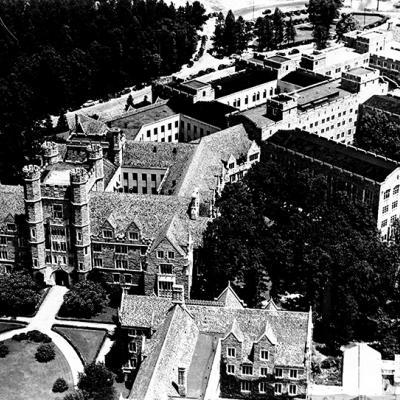Image

|
Image
 |
Davison Building | 1930 - Present | Originally built to house administration, classrooms and research laboratories for the School of Medicine, the Davison Building connected directly with Duke Hospital and was intentionally placed at the end of the West (Abele) Quadrangle to connect it to the rest of the University. It was later renamed to honor founding dean Wilburt Davison. |
|
Image
 |
Duke Forest | 1930 - Present | Beginning with the purchase of small woodlots and failed farms in the 1920s, the forest is now more than 7,000 acres of hardwood and pine in six divisions. It is used for research on climate change and ecology and in teaching forestry and timber management. |
|
Image
 |
Bell Building | 1947 - 2012 | Duke University's first dedicated research building, named for William Brown Bell, President of American Cyanamid. It was built with funds from the Duke Endowment, the Rockefeller Foundation and the Dorothy Beard Foundation. It housed Duke's first electron microscope. Demolished to make room for the Duke Medical Pavilion in the 2010s. |
|
Image
 |
TUNL - Triangle Universities Nuclear Lab | 1965 - Present | A regional laboratory shared by faculty and students of Duke, UNC and NC State. It features a 15 Mev cyclotron injector and a tandem Van de Graaff accelerator to produce light ion beams. One of the first physics labs in the country to use a specially adapted general purpose computer to collect experimental data. It is located between French Family Science Center and Levine Science Research Center |
|
Image
 |
Nanaline Duke Building | 1968 - Present | Named for James B. Duke's second wife, Mrs. Walker P. Inman (née Nanaline Holt of Macon, Ga.), mother of Doris Duke. Houses labs and offices of Biochemistry, Cell Biology, Dermatology and Neurobiology. |
|
Image
 |
Paul M. Gross Hall | 1968 - Present | Built in 1968 as a chemistry research and teaching building to replace "old chemistry" on the west quad, it was converted to other uses in 2014, after completion of French Family Science Center. It currently houses the Social Science Research Institute, Duke Energy Initiative, Rhodes Information Initiative and The Foundry, a space for student teams to fabricate their projects. |
|
Image
 |
Center for Hyperbaric Medicine and Environmental Physiology | 1968 - Present | A collection of seven pressure vessels used for research on human blood gases and pressure effects. Also aids in the treatment of about 250 patients per year for carbon monoxide poisoning, decompression sickness and wound-healing. In 1981, three volunteers lived in one of the lab's chambers for a world-record 43 days to simulate being 2,250 feet below the ocean’s surface. |
|
Image
 |
DFELL - Duke Free Electron Laser | 1991 - Present | The 52,000 square foot DFELL has two free electron laser light sources capable of generating intense infrared and ultraviolet radiation. A 1.2 GeV storage ring provides tunable coherent radiation from 400 nm to 193 nm. Intense gamma rays are produced by internal backscattering. The Lab on Science Drive is part of the TUNL facilities. |
|
Image
 |
LSRC - Levine Science Research Center | 1994 - Present | Built to house a mix of disciplines, it comprises 341,000 square feet of wet lab, office and classroom space for the Nicholas School of the Environment, The Duke Institute for Brain Sciences, Pharmacology & Cancer Biology, and Computer Science and labs for nine other School of Medicine units. |
|
Image
 |
Duke Human Vaccine Institute | 1996 - Present | Formed to develop vaccines and therapies against HIV and AIDS, now addresses influenza and emerging infectious diseases, including novel coronaviruses. |
|
Image
 |
Fitzpatrick Center for Interdisciplinary Engineering, Medicine and Applied Science (CIEMAS) | 2004 - Present | This two-part laboratory building was created to literally and figuratively bridge genomic science and engineering. Now home to engineering and genomic and computational biology. |
|
Image
 |
French Family Science Center | 2007 - Present | A 280,000 square foot building housing wet and dry labs for research and teaching, classrooms and faculty offices for chemistry, genomics, materials science and nanoscience. Named for the family of Melinda French Gates, Trinity 1986, Fuqua 1987. |
|
Image
 |
Mary Duke Biddle Trent Semans Center for Medical Education (Trent Semans) | 2013 - Present | Opened in 2013 as the new home for medical education, it features a floor of 'Simulation Laboratories' for medical training. Named for Mary Duke Biddle Trent Semans, niece of J.B. Duke and a trustee of the Duke Endowment for 55 years. |